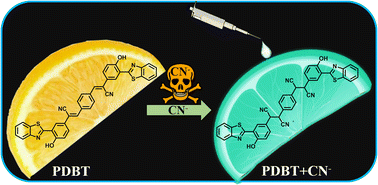A benzothiazole appended 2,2′-(1,4-phenylene)diacetonitrile derivative (2Z,2′Z)-2,2′-(1,4-phenylene)bis(3-(3-(benzo[d]thiazol-2-yl)-4-hydroxyphenyl)acrylonitrile) (PDBT) has been synthesized and investigated as a novel sensor, capable of showing high selectivity and sensitivity towards CN− over a wide range of other interfering anions. After reaction with CN−, PDBT shows a new absorption peak at 451 nm with a color transformation from colorless to reddish-brown. When yellow fluorescent PDBT is exposed to CN−, it displays a significant increase in fluorescence at 445 nm, resulting in strong sky-blue fluorescence emission. The nucleophilic addition reaction of CN− plays a role in the sensing mechanism of PDBT to CN−. PDBT can distinguish between a broad variety of interfering anions and CN− with remarkable selectivity and sensitivity. Furthermore, the detection limit of the PDBT probe for CN− is 0.62 μM, which is significantly lower than the WHO standard of 1.9 μM for drinking water. Density functional theory simulations corroborated the observed fluorescence changes and the internal charge transfer process that occurs after cyanide ion addition. In addition, real-time applications of PDBT, such as cell imaging investigations and the detection of CN− in water samples, were successfully carried out.

